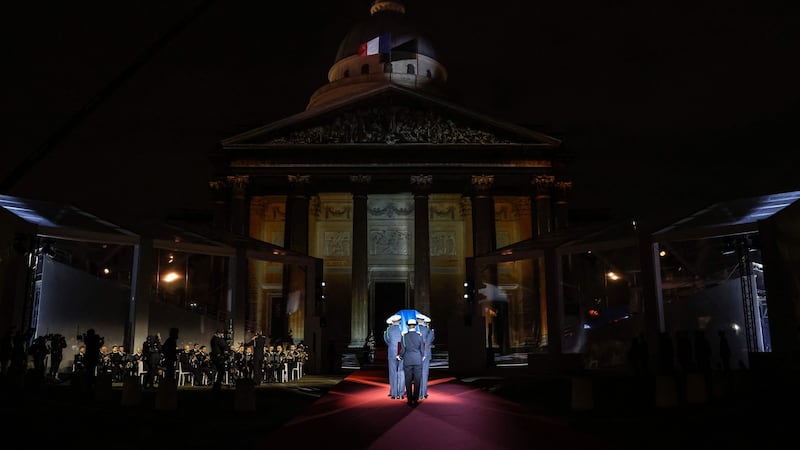Josephine Baker (1906-1975) must have been the happiest woman in heaven on Tuesday night, when President Emmanuel Macron inducted her into the Panthéon, France's temple to its great men and women, with the pomp and splendour that France does so well. It was a secular beatification, almost an apotheosis.
A coffin holding earth from four places dear to Baker – St Louis, Missouri, her birthplace; Paris; Les Milandes, her chateau in Dordogne for 30 years, and Monaco, where she is buried near her beloved friend, Princess Grace – was carried slowly up the red-carpeted rue Soufflot by six pallbearers from the French air force. (Baker held the rank of 2nd Lieutenant in the air force during the second World War).
An aviatrix followed, carrying the five medals that Baker was so proud of on a red velvet cushion, among them Chevalier de la Légion d’Honneur, Croix de Guerre 1939/1945 and Médaille de la Résistance. The blue, white, and red tricolour was omnipresent.

When Baker stood beside Martin Luther King at the Lincoln memorial in Washington DC for his "I have a dream" speech on August 28th, 1963, she wore her French air force uniform and medals. It was, she said, the happiest day of her life.
Two thousand people attended the Paris ceremony. Residents of the rue Soufflot watched from their balconies and applauded. Macron sat between his wife Brigitte and Prince Albert of Monaco, surrounded by 10 of Baker's 12 adopted children.
Baker’s extraordinary life was recounted in a Broadway-style show, projected onto the facade of the Panthéon. She was born Josephine McDonald to a mother called Carrie, the daughter and granddaughter of slaves, father unknown. At age 7, her mother sent Josephine to work for a cruel white woman who made her sleep on the floor and punished the child by plunging her hands into boiling water. Carrie married Josephine off to an older man at age 13. She hit him with a bottle and escaped, joined a travelling show, and married again two years later, this time to a man called Baker, the name she kept for the rest of her life.
How a child born into such dire circumstances could grow up the very embodiment of lightness and joy is a mystery. Macron summarised Baker’s life: “War heroine. Fighter. Dancer. Singer. Black defending blacks, but above all a woman defending human beings.”
Fairytale castle
Baker often said there was only one race, the human race. After the war, she purchased a fairytale castle and with her fourth husband, the orchestra conductor Jo Bouillon, and adopted children from all over the world. Macron listed them on Tuesday night: "Akio and Teruya from Japan; Luis from Colombia; Jari from Finland; Jean-Claude, Moise and Noel from France; Brian and Marianne from Algeria; Koffi from the Ivory Coast; Tara from Venezuela and Stellina from Morocco."
Baker cooked spaghetti Bolognese for the children she called her rainbow tribe on Sunday nights. Don’t become entertainers, she warned them. The children saw on television footage of their mother’s first hit performance in France, doing the Charleston, bare-breasted and naked except for a skirt made of foam-rubber bananas. It was not her, she insisted adamantly.
Referring to the banana dance, which would be unthinkable today, Macron said that Baker had used comedy – puffed out cheeks, crossed eyes and jerky gestures – to mock the colonial prejudices of the period.

Baker was the best-paid performer in Europe in the 1920s. She indulged in a star’s excesses, walking her pet cheetah on a lead, driving through Paris in a convertible car upholstered in lizard skin. She toured the world and licensed her name for hair products called Bakerfix and Bakeroil. White women imitated her slicked-down hair with a Kewpie curl on the forehead. It was an era of great sexual freedom. Macron alluded to reports of Baker’s bisexuality: “Next to a man one night, in the arms of a woman another . . . In just a few years, Josephine Baker creates her legend.”
One wonders if Baker could possibly have had all the lovers attributed to her: Fidel Castro, Jean Gabin, Ernest Hemingway, Le Corbusier, Georges Simenon, King Mohamed V of Morocco, Colette and Frida Kahlo.
Joining the Resistance
But it was Baker’s later, politically engaged actions which led to her induction into the Panthéon: the way she joined the Resistance as soon as the war started, saying “France gave me everything. I am ready to give my life for her”, and her commitment to the fight for civil rights and human rights.
Baker abhorred racism, but fame, fortune and beauty did not exempt her from segregation in the US. Macron portrayed her as a symbol of French universalism. Her battle, he said, “was not to affirm her identity as black . . . but to be a free and dignified citizen.”
Baker symbolised “the elusive beauty of our collective destiny”, Macron said. With her, “for the first time, a certain idea of liberty, of the fête” entered the Panthéon: “You enter our Panthéon because, born American, there is no one more French than you.”
Earlier in the ceremony, a recording of Baker’s voice warbled “J’ai deux amours, mon pays et Paris” above the Latin Quarter. Her voice was, a critic of the time wrote, “a curious instrument that sounds like a saxophone, a muffled horn and a flute.”
Macron called the song “a hymn to love” and paraphrased it in his ultimate accolade: “My France is Josephine.”











